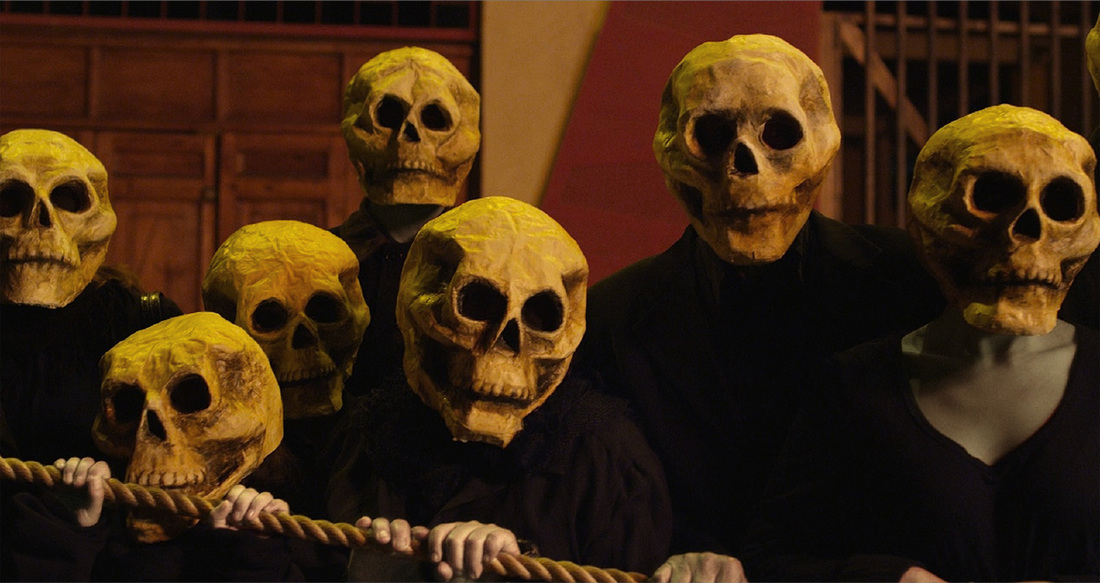Dance of Reality
|
Chilean director Alejandro Jodorowsky first premiered El Topo in 1970 with midnight screenings at New York’s Elgin Theater. Soon the film was drawing cult audiences at Cambridge’s legendary Orson Welles Cinema. Thus began the Midnight Movie Craze. Night Of The Living Dead, The Harder They Come, Eraserhead, and The Rocky Horror Picture Show all drew considerable followings. But what really appealed to a generation steeped in Carlos Castaneda and Timothy Leary? A surrealistic landscape featuring the director Jodorowsky on horseback, dressed from head-to-toe in black leather and accompanied by his naked 5 year-old son: the pair encountered mystical adventures in a broiling desert filled with buckets of blood, limbless actors, and lots of dead rabbits
|
|
Jodorowsky followed it with the freaked-out visions of The Holy Mountain in 1973 and Sante Sangre 17 years later. These were films crammed with inscrutable images, indecipherable mythologies, and references to the Kabbalah, Christianity, alchemy, futurism, mysticism, politics, and much, much more. What did it all mean? Ah, youth.
During a hiatus of 24 years, in which he claims he produced 40 books, 80 comics, theater performances, exhibitions of his drawings, tarot training courses, and came very close to creating a visionary film version of Frank Herbert’s Dune (chronicled in the documentary Jodorowsky’s Dune), Jodorowsky prepared for his return to the cinematic wild side with The Dance of Reality. It is based on his book of the same name in which he wrote about his harsh upbringing in Tocopilla, a coastal town on the edge of the Chilean desert. The film was shot in the very locations where he grew up and blends metaphor, mythology, and music to conjure up an autobiography of his troubled childhood that is a ‘dance’ of memory and imagination. Jodorowsky calls his creative process “psychomagic,” a practice about which he has lectured for decades and which is the subject of another of his books Psychomagic: The Transformative Power of Shamanic Psychotherapy. The practice claims that “psychological realizations can cause true transformation when manifested by concrete poetic acts.” Attempting to come to terms with his early life as the homely Jewish son of a harsh disciplinarian father, the director has made use of dreams, art, and now this film to heal wounds that have “traveled through generations.” His father, Jaime, is played by his own son Brontis Jodorowsky (the little boy on the horse in El Topo) who is now 52 years old. His sons Adan and Cristobal also appear in the film. The film is shocking and confessional and veers off into some elaborate fictions. He depicts his father slapping him as a child to see how long he could keep from crying and then, to test the boy’s manhood, he forbids the dentist to use an anaesthetic while he fixes the child’s broken tooth. I presume that scene is true, but did his Jamie really try to assassinate Carlos Ibáñez, the dictator of Chile? Or did he, a Stalinist who tailored his dress and mustache after the Russian tyrant, only dream of doing the deed? The film recounts the attempt in a fantastical and protracted scenario. Throughout, the director attempts to redeem his mother, Sara, who wanted to be an opera singer, and whom he calls “a humiliated woman,” by having her sing all her lines. It soon begins to feel overly gimmicky. In one scene Pamela Flores, the actress playing the role of the matriarch, is making love to her husband. She lifts her skirt to pee on Jodorowsky’s father who is, of course, being played by the director’s own son. The psychomagical process gets a bit disconcerting. The real question is this: does the film confound us like El Topo once did, or does it mirror the stylistic approaches of the filmmakers Jodorowsky admires: the elegance of Bunuel, the humanity of Fellini’s carnavalesque, the mythological poetry of Werner Herzog? Unfortunately, Jodorowsky is too deep into his own head to make the accumulation of colorfully staged and dreamlike scenarios add up to all that much. The director says, “I travel in time to save myself. I created a relationship between myself and my interior child.” In doing so in such a private way, however, he leaves viewers behind. The evening I attended, the credits rolled, the audience hesitated, someone clapped and finally applause broke out. Judging from the age of the crowd, most were not born when El Topo was released, but they wanted to acknowledge the film’s freedom and effort. To their credit, they are hungry for bold and radical voices in cinema and art. Jodorowsky is a fascinating artist, but this rehash of his own style (and of others) is lurid, stale, and simplistic. It would be better for young audiences to go back and spend some quality time with the tried and true canon of Bunuel, Fellini, Herzog, or even David Lynch and Peter Greenaway. |
